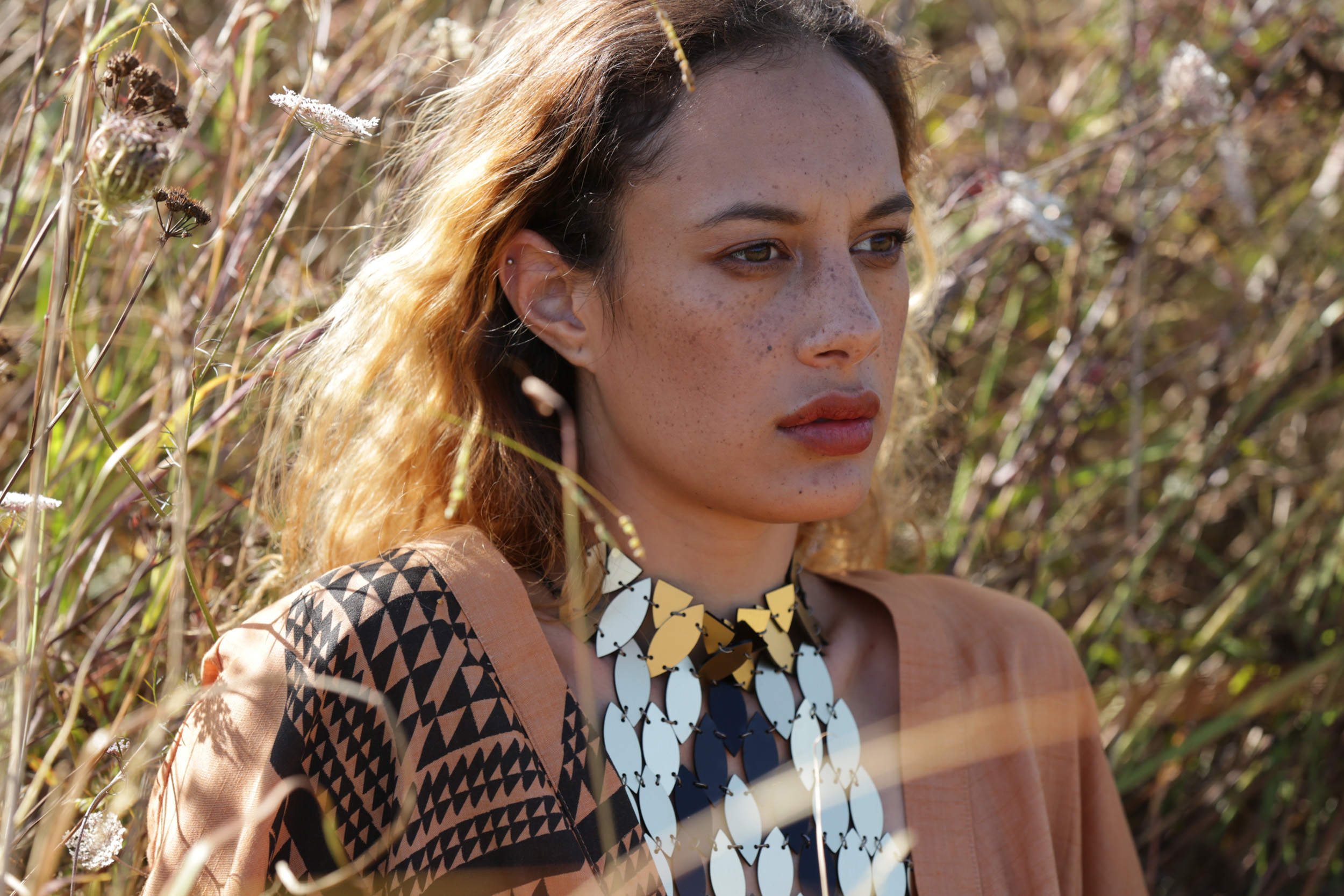Photography David Shields
Understanding maramataka, the Māori moon cycle, and matariki. As a salute to matariki Good magazine brought together some of New Zealand’s leading Māori fashion designers for a very special shoot that celebrates New Year in Aotearoa.
I’m an autumn person. A lot of us associate this season with falling leaves but in Aotearoa our native plants are almost entirely not deciduous, they like to keep a coat on during the cooling months. Yes, that’s me, too.
As we move into winter it’s a time to huddle, to bunk down and enjoy the shorter days and longer nights. More sleep, more rest, boost our immune systems as winter is a risky time in terms of human health.
Matariki, the Māori new year is conveniently in winter and marks the rising of the Matariki star cluster. If the stars are shining bright it’s a sign of a prosperous year ahead, if not, prepare for a hard one and work extremely smart.
These are signs that our ancestors observed, and we seek to make sense of this today in our ever-changing world.

Our whānau celebrates Matariki on the first new moon of Pipiri (June). We are practitioners of maramataka, the Māori moon cycle. The new moon, or Whiro represents the beginning of a new phase.
This year, Whiro falls on June 21st. We begin preparing a few weeks before, no stress, just a gentle easing into the moment.
We usually have about five or six get-togethers, sometimes extending out to July. We eat with friends and family and attend community events – much like Christmas really. My tamariki even get a pillowcase full of presents to wake up to from their Nana Meagan – winter thermals, hot water bottles and those kinds of practical gifts wrapped in recycled paper.
Reflecting on aroha
I don’t know about you, but I find winter slightly depressing so eating yummy kai really cheers me up. Homemade steamed pudding (yet to find a sugar-free version), custard and cream, hot hāngī, free-range whole chickens cooked in the bag, steamed organic peruperu (Māori potatoes), rēwena bread and real butter mmm – all hearty soul food that connects us with our ancestors and demonstrates our continual survival. Winter is definitely not a time to fast!
If we have nothing to eat in winter, or to sustain us during this tough period, then it’s a measure that were not working right and things need to change.
I’m big on ritual and love to recreate ways to better connect my tamariki to their environment. At night on Whiro, when the sky is at its absolute darkest for the month, we venture outside to gaze at the mass of stars spread across the sky. Māori believe that when we die, we become stars twinkling in the night sky… “Ko ratou ma kua wheturangitia (those departed that are now stars in the sky)”.

Matariki is a marker to reflect and acknowledge our loved ones who have now gone. My tamariki and I peer at the sky wrapped in our blankets with the house lights turned off. We call out aroha (love) and the names of our whānau who have recently departed.
“Aroha Papa,” the children call, “Aroha Papa, aroha Nana Chicky”. Yes aroha Nana Chicky and once the baby of the family even called out our dog’s name, “aroha Kuri”.
This act brings on a sense of great peacefulness and the tamariki know that our loved ones are watching over us.

As winter moves forward it’s time to review the past year and discuss what we may need to improve on. Just after Matariki is a great time for wānanga, higher learning and self-development. We are bound to home more often because of the elements, and of course our physical activity is not as intense, therefore it’s a great time to exercise the brain!
Traditionally we would huddle together and seek to understand the meaning of the universe. This is my busy time teaching maramataka planning workshops and encouraging people to move from talking about what our ancestors did towards applying and actioning those believes and practices in a modern-day setting.
Harnessing energies
I have been teaching maramataka planning for more than 20 years and have trained well over 4000 maramataka practitioners nationwide. What I love about the growing interest in maramataka is the recognition that there is a right time to perform certain activities according to the moon and environmental energies.
Just like our ancestors, it’s not viable to waste energy and resources to go fishing on a moon that’s unproductive to catching a fish.
Similarly, it is not productive to orchestrate a major event on the moon of Whiro, low energy! Whiro is the beginning and just like the start of anything it takes a lot of work to get going. It’s best to reserve this moon of Whiro for gentle self-reflective activities. Mark it as a starting point, but don’t rush in.

Maramataka is based on thousands of years of observations classified in a system with the moon as a primary indicator. The knowledge is handed down through the generations and although there are some tribal variations, the names of each moon phase is ancient te reo with its origin being from Hawaiki.
The microclimate of each iwi (tribe) is where the difference in classification really is. Lake iwi have a different environment to those on the East coast. West coast is extremely different to mountain tribes.
In my case, those of us based in Mōtatau have a different maramataka to my relations just over the hill in Pīpīwai. This traditional knowledge has really only been missing from our families since we left the gardens.
Maramataka also teaches us about being prepared, to plan ahead. My tribe, Ngāti Hine, are inland swamp people whose survival is dependent on the humble tuna (eel). We know that at a certain time of year, usually around the first rains of early March and three or so moons before Whiro, the tuna makes their move to breed in the seas near Tonga.
If we are not prepared for this run of tuna, we essentially miss out on catching our food source that will sustain us during winter.
Most alarmingly living on my whenua and close to the Ramarama Stream, I have witnessed the tuna not run for two years due to low water levels in the creek. This is no doubt reflective of climate change. Maramataka teaches us to observe our surroundings, and with this ancient classification system and my recent comparisons of nature’s activities the indications are that the environment is indeed changing and drastically.

On a lighter note, and something for you to wānanga about as you are enjoying your Matariki roast kūmara dinner with venison and miro berry red wine jus…
Maramataka means the Māori lunar cycle and most importantly māramatanga means understanding. This is ultimately what we are trying to achieve through better aligning with our environment. True understanding, māramatanga!
Āe mārika, yes indeed, the clock of New Zealand is based on our northern-hemisphere colonisers’ time system. They brought it here and the people just can’t seem to let it go. Wouldn’t it be perfect to realign with the southern seasons and maramataka Māori to reflect the beautiful Aotearoa environment we live in?

Ngā mihi o te tau hou. New year’s greetings.

Heeni Hoterene is an educator and maramataka practitioner.
Model Hazel Wineera-Ellis of Ataahua Models. Location Little Wilderness. Photography David Shields. Hair Guy Roberts from Vada. Make-up Emma Peters of Aleph Beauty. Styling Carolyn Enting. Art direction Lisa Lodge.







